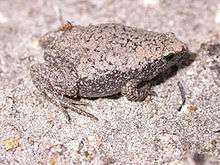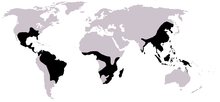Microhylidae
The Microhylidae, commonly known as narrow-mouthed frogs, are a geographically widespread family of frogs. The 683 species are in 63 genera and 11 subfamilies,[2] which is the largest number of genera of any frog family.[3]
| Microhylidae | |
|---|---|
 | |
| Eastern narrowmouth toad (Gastrophryne carolinensis) | |
| Scientific classification | |
| Kingdom: | Animalia |
| Phylum: | Chordata |
| Class: | Amphibia |
| Order: | Anura |
| Suborder: | Neobatrachia |
| Family: | Microhylidae Günther, 1858 |
| Subfamilies | |
|
Asterophryinae | |
 | |
| Distribution of Microhylidae (in black) | |
Evolution
A molecular phylogenetic study by van der Meijden, et al. (2007) has estimated the initial internal divergence of the family Microhylidae to have taken place about 66 million years ago, or immediately after the Cretaceous extinction event.[1] The most recent common ancestor of the Microhylidae and their closest ranoid relatives is estimated to have lived 116 million years ago in Gondwana.[1]
Description
As suggested by their name, microhylids are mostly small frogs. Many species are below 1.5 cm (0.59 in) in length, although some species are as large as 9 cm (3.5 in).[4] They can be arboreal or terrestrial, and some even live close to water. The ground-dwellers are often found under leaf litter within forests, occasionally venturing out at night to hunt. The two main shapes for the microhylids are wide bodies and narrow mouths and normal frog proportions. Those with narrow mouths generally eat termites and ants, and the others have diets typical of most frogs. Egg-laying habits are highly varied.
Reproduction
The microhylids of New Guinea and Australia completely bypass the tadpole stage, with direct development from egg to frog. The arboreal species can therefore lay the eggs within the trees, and never need venture to the ground. Where species do have tadpoles, these almost always lack the teeth or horny beaks typical of the tadpoles of other families.[4]
Anatomy
The skull has paired palatines and frontoparietals. The facial nerve passes through the anterior acoustic foramen in the auditory capsule; the trigeminal and facial nerve ganglia are fused to form a prootic ganglion. The eight (or seven) presacral holochordal vertebrae are all procoelous except for a biconcave surface on last presacral. The pectoral girdle is firmisternal and some show reduced clavicle and procoracoids. The terminal phalanges are blunt, pointed, or T-shaped. The tadpole lacks keratinized mouth parts and has a large spiracular chamber emptied by a caudomedial spiracle.[5]
Taxonomy
- subfamily Adelastinae Peloso, Frost, Richards, Rodrigues, Donnellan, Matsui, Raxworthy, Biju, Lemmon, Lemmon, & Wheeler, 2015
- genus Adelastes Zweifel, 1986
- subfamily Asterophryinae Günther, 1858
- genus Aphantophryne Fry, 1917
- genus Asterophrys Tschudi, 1838
- genus Austrochaperina Fry, 1912
- genus Barygenys Parker, 1936
- genus Callulops Boulenger, 1888
- genus Choerophryne Van Kampen, 1914
- genus Cophixalus Boettger, 1892
- genus Copiula Méhely, 1901
- genus Gastrophrynoides Noble, 1926
- genus Hylophorbus Macleay, 1878
- genus Mantophryne Boulenger, 1897
- genus Oninia Günther, Stelbrink & von Rintelen, 2010
- genus Oreophryne Boettger, 1895
- genus Paedophryne Kraus, 2010
- genus Siamophryne Suwannapoom, Sumontha, Tunprasert, Ruangsuwan, Pawangkhanant, Korost, and Poyarkov, 2018
- genus Sphenophryne Peters & Doria, 1878
- genus Vietnamophryne Poyarkov, Suwannapoom, Pawangkhanant, Aksornneam, Duong, Korost and Che, 2018
- genus Xenorhina Peters, 1863
- subfamily Chaperininae Peloso, Frost, Richards, Rodrigues, Donnellan, Matsui, Raxworthy, Biju, Lemmon, Lemmon, & Wheeler, 2015
- genus Chaperina Mocquard, 1892
- subfamily Cophylinae Cope, 1889
- genus Anilany Scherz, Vences, Rakotoarison, Andreone, Köhler, Glaw, and Crottini, 2016
- genus Anodonthyla Müller, 1892
- genus Cophyla Boettger, 1880
- genus Madecassophryne Guibé, 1974
- genus Mini Scherz, Hutter, Rakotoarison, Riemann, Rödel, Ndriantsoa, Glos, Roberts, Crottini, Vences & Glaw, 2019
- genus Plethodontohyla Boulenger, 1882
- genus Rhombophryne Boettger, 1880
- genus Stumpffia Botteger, 1881
- subfamily Dyscophinae Boulenger, 1882
- genus Dyscophus Grandidier, 1872
- subfamily Gastrophryninae Fitzinger, 1843
- genus Arcovomer Carvalho, 1954
- genus Chiasmocleis Méhely, 1904
- genus Ctenophryne Mocquard, 1904
- genus Dasypops Miranda-Ribeiro, 1924
- genus Dermatonotus Méhely, 1904
- genus Elachistocleis Parker, 1927
- genus Gastrophryne Fitzinger, 1843
- genus Hamptophryne Carvalho, 1954
- genus Hypopachus Keferstein, 1867
- genus Myersiella Carvalho, 1954
- genus Stereocyclops Cope, 1870
- subfamily Hoplophryninae Noble, 1931
- genus Hoplophryne Barbour & Loveridge, 1928
- genus Parhoplophryne Barbour & Loveridge, 1928
- subfamily Kalophryninae Mivart, 1869
- genus Kalophrynus Tschudi, 1838
- subfamily Melanobatrachinae Noble, 1931
- genus Melanobatrachus Beddome, 1878
- subfamily Microhylinae Günther, 1858
- genus Glyphoglossus Gunther, 1869 "1868"
- genus Kaloula Gray, 1831
- genus Metaphrynella Parker, 1934
- genus Microhyla Tschudi, 1838
- genus Micryletta Dubois, 1987
- genus Mysticellus Sonali & Biju, 2019
- genus Phrynella Boulenger, 1887
- genus Uperodon Duméril & Bibron, 1841
- subfamily Otophryninae Wassersug & Pyburn, 1987
- genus Otophryne Boulenger, 1900
- genus Synapturanus Carvalho, 1954
- subfamily Phrynomerinae Noble, 1931
- genus Phrynomantis Peters, 1867
- subfamily Scaphiophryninae Laurent, 1946
- genus Paradoxophyla Blommers-Schlösser & Blanc, 1991
- genus Scaphiophryne Boulenger, 1882
Range
Frogs from the Microhylidae occur throughout the tropical and warm temperate regions of North America, South America, Africa, eastern India, Sri Lanka, Southeast Asia, New Guinea, and Australia. Although most are found in tropical or subtropical regions, a few species can be found in arid or nontropical areas. They are the majority of frog species in New Guinea and Madagascar.
The ranges of each subfamily are:[6]
- Hoplophryninae: Africa
- Scaphiophryninae: Madagascar
- Dyscophinae: Madagascar
- Microhylinae: Southeast Asia, East Asia, South Asia
- Asterophryinae: Australia, New Guinea
- Phrynomerinae: Africa
- Kalophryninae: Southeast Asia
- Otophyninae: South America
- Cophylinae: Madagascar
- Gastrophryninae: New World
- Melanobatrachinae: South Asia
- Chaperininae: Southeast Asia
- Adelastinae: South America
References
- van der Meijden, A., M. Vences, S. Hoegg, R. Boistel, A. Channing, and A. Meyer. 2007. Nuclear gene phylogeny of narrow-mouthed toads (family: Microhylidae) and a discussion of competing hypotheses concerning their biogeographical origins. Mol. Phylogenet. Evol. 44:1017–1030.
- Amphibiaweb. "Microhylidae". Amphibiaweb. Retrieved 2 April 2020.
- Blackburn, D.C.; Wake, D.B. (2011). "Class Amphibia Gray, 1825. In: Zhang, Z.-Q. (Ed.) Animal biodiversity: An outline of higher-level classification and survey of taxonomic richness" (PDF). Zootaxa. 3148: 39–55.
- Zweifel, Robert G. (1998). Cogger, H.G.; Zweifel, R.G. (eds.). Encyclopedia of Reptiles and Amphibians. San Diego: Academic Press. pp. 102–103. ISBN 0-12-178560-2.
- Caldwell, George R. Zug; Laurie J. Vitt; Janalee P. (2001). Herpetology : an introductory biology of amphibians and reptiles (2. ed.). San Diego [u.a.]: Academic Press. ISBN 0-12-782622-X.
- De Sá, R. O., Streicher, J. W., Sekonyela, R., Forlani, M. C., Loader, S. P., Greenbaum, E., … Haddad, C. F. B. (2012). Molecular phylogeny of microhylid frogs (Anura: Microhylidae) with emphasis on relationships among New World genera. BMC Evolutionary Biology, 12, 241. http://doi.org/10.1186/1471-2148-12-241
External links
| Wikispecies has information related to Microhylidae |
| Wikimedia Commons has media related to Microhylidae. |